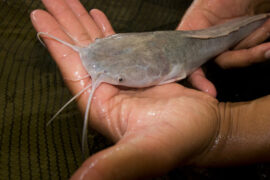Introduction
Catfish farming is a great way to produce a sustainable, year-round food source while also providing valuable income.
Imagine a world where you could enjoy fresh, delicious catfish without leaving your backyard. With a little bit of land and some basic equipment, you can!
In this article, we’ll explore the basics of catfish farming and discuss some of the benefits that come with it. Are you ready to get started?

What Is Catfish Farming?
Catfish farming is the process of raising catfish in captivity for human consumption. Catfish are freshwater fish that are native to the United States and parts of Asia.
There are a number of benefits to raising catfish in captivity. First, catfish are cold-water fish, so they can be grown in climates that are cooler than what is necessary for other types of fish. This makes them an ideal choice for farmers in temperate climates.
Second, catfish are omnivorous and can survive on various food sources, making them easy fish to farm. They also grow quickly, reaching market size in about 12 months. And finally, catfish are a popular fish for human consumption, so there is a large demand for them.
Benefits of Catfish Farming
There are many benefits to catfish farming. Some of the most notable include:
1. Low cost and easy to manage: Catfish farming is a relatively low-cost and easy-to-manage operation, which makes it a popular choice for small-scale farmers.
2. High yields: Catfish is a high-yield fish, which means they can produce a lot of meat in a short amount of time.
3. Versatile: Catfish are versatile fish and can be used for a variety of purposes, including food, bait, and fertilizer.
4. Sustainable: Catfish farming is a sustainable form of agriculture that does not rely on wild fish stocks for production.
Challenges Faced in Catfish Farming
Before getting into the benefits of catfish farming, it’s important to be aware of some of the challenges that come with it. Here are a few of the most common ones:
– Unreliable water sources: One of the main requirements for raising catfish is a consistent water supply. If the water level is too low, the fish can’t breathe, and if it’s too high, they can’t stay in one spot and eat the food you’ve provided for them.
– Lack of knowledge and experience: Catfish farming is still a relatively new concept in many parts of the world, so many farmers don’t have the knowledge or experience to do it successfully.
– Poor land quality: If your farm is situated on poor-quality land, that will affect your ability to raise healthy catfish. The soil needs to be nutrient-rich to support its growth and development.
The Economics of Catfish Farming
Not only is catfish farming good for the environment, but it’s also good for your wallet.
Catfish are a very profitable fish to farm. They’re fast growers and they don’t require a lot of expensive feed. In fact, they can be raised on a diet of plant proteins and grains, which makes them a very economical choice.
What’s more, catfish are in high demand, so you can always find a market for your product. And since they’re farmed in freshwater ponds, they’re relatively easy to farm and don’t require a lot of expensive equipment.
So if you’re looking for a way to make some extra money, or even start your own business, catfish farming might be the perfect solution.
Tips for Setting Up a Successful Catfish Farm
Here are a few tips to get you started on the right track:
– Decide what type of catfish you want to farm. There are three main types of catfish: channel, blue, and flathead. Channel catfish are the most popular, as they’re relatively easy to farm and have a high demand.
– Choose the right location. Catfish need warm water to thrive, so your farm should be located in an area with a consistent water temperature of at least 70 degrees Fahrenheit. You’ll also need to have access to a reliable water source, like a river or lake.
– Create the perfect environment. To create a hospitable environment for your catfish, you’ll need to make sure the pond has enough oxygen and food. You can do this by adding aerators and stocking the pond with baitfish.
– Keep an eye on your fish. It’s important to monitor your catfish regularly to make sure they’re healthy and happy. Check the water quality, look for signs of disease, and keep an eye on the growth rates.
Common Mistakes in Catfish Farming
One mistake that often happens is not properly preparing the land before starting to farm. The land must be cleared of any vegetation and the area needs to be level. If there are any trees on the land, their roots need to be removed as well. If you don’t do this, the roots will rot and release toxins into the water, killing the fish.
Another mistake is not taking into account the climate. Catfish like warm water, so if you live in an area with a colder climate, you’ll need to invest in a heated pond.
And finally, one more mistake that’s often made is not keeping a close eye on the fish. Make sure to check on them regularly to ensure they’re healthy and happy. If you see any sick fish, remove them from the pond immediately to prevent the spread of disease.
Conclusion
So, if you’re considering getting into catfish farming, there are a few things you need to keep in mind. Firstly, you need to make sure you have a good source for quality catfish broodstock. Secondly, you need to have a good understanding of the local climate and water conditions, and make sure you’re set up for success in those areas. Finally, make sure you have a solid marketing plan in place to sell your catfish to local restaurants and retailers.
With a little bit of planning and preparation, you can be on your way to a successful catfish farming business. So, what are you waiting for? Get started today!


